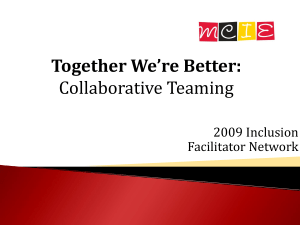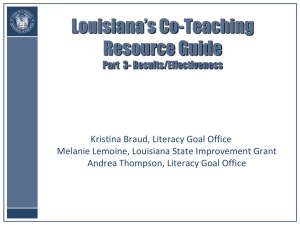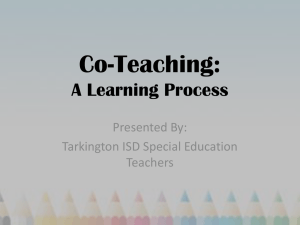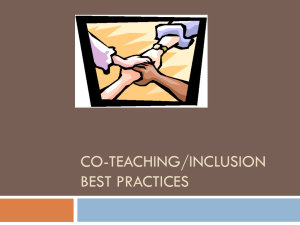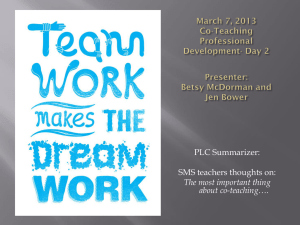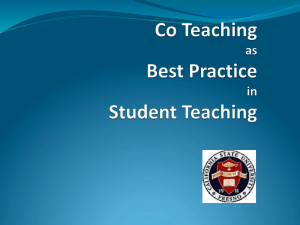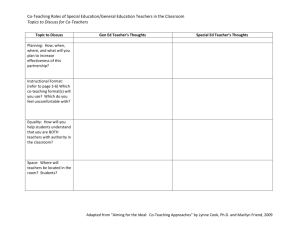Chapter 2 Collaboration Between Professional Educators and
advertisement
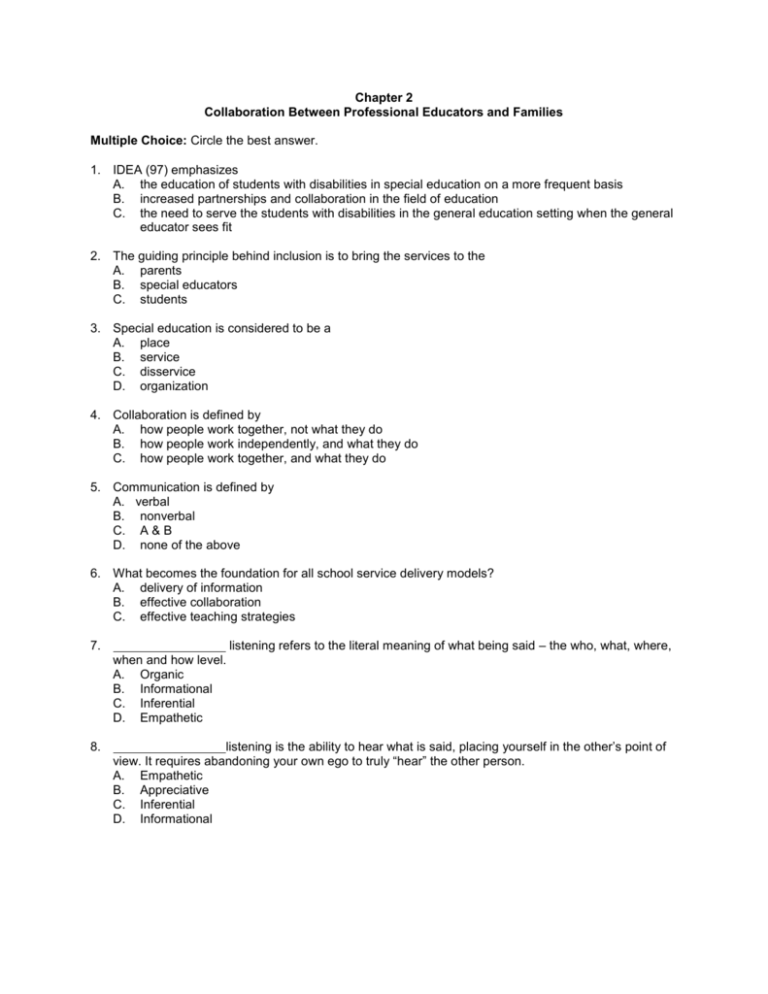
Chapter 2 Collaboration Between Professional Educators and Families Multiple Choice: Circle the best answer. 1. IDEA (97) emphasizes A. the education of students with disabilities in special education on a more frequent basis B. increased partnerships and collaboration in the field of education C. the need to serve the students with disabilities in the general education setting when the general educator sees fit 2. The guiding principle behind inclusion is to bring the services to the A. parents B. special educators C. students 3. Special education is considered to be a A. place B. service C. disservice D. organization 4. Collaboration is defined by A. how people work together, not what they do B. how people work independently, and what they do C. how people work together, and what they do 5. Communication is defined by A. verbal B. nonverbal C. A & B D. none of the above 6. What becomes the foundation for all school service delivery models? A. delivery of information B. effective collaboration C. effective teaching strategies listening refers to the literal meaning of what being said – the who, what, where, 7. when and how level. A. Organic B. Informational C. Inferential D. Empathetic 8. listening is the ability to hear what is said, placing yourself in the other’s point of view. It requires abandoning your own ego to truly “hear” the other person. A. Empathetic B. Appreciative C. Inferential D. Informational 9. listening is the ability to pull all of the types of listening together and appreciate what is being said due to the integration of all the levels. A. Empathetic B. Appreciative C. Informational D. Organic 10. is the key to successful integration of students at risk and those with disabilities into the general education environment. A. Communication B. Information C. Consultation D. Appreciation 11. The major purposes of collaborative consultation are A. prevent learning and behavioral problems, to remediate learning and behavioral problems, and to coordinate instructional programs B. prevent learning and behavioral problems and to remediate learning and behavioral problems C. prevent learning and behavioral problems and to coordinate instructional programs 12. Which of the following is not a role of the special education teacher consultant? A. help general educators understand that students with special needs can successfully participate in inclusive settings B. facilitate instructional or curricular decision made by the general classroom teacher or among team members regarding an individual student’s educational needs C. persuade general educators that students with special needs cannot participate in inclusive settings 13. is where the special educator provides technical assistance to the general class teacher. A. Direct consultation B. Indirect consultation C. Co-teaching 14. Which of the following is not a role of the special educator consultant? A. arrange the physical environment B. plan for instruction C. prepare or adapt lesson plans/materials D. deliver direct instruction to students 15. is where the special education teacher carries out some direct instruction within the general classroom setting. A. Direct consultation B. Indirect consultation C. Co-teaching 16. is where the special educator has increased responsibility for classroom instruction and often takes the lead in activities such as child study. A. Direct consultation B. Indirect consultation C. Co-teaching 17. Which of the following is not a characteristic of co-teaching? A. co-teaching requires that both teachers share equal responsibility B. the opportunity for co-teachers to combine their individual strengths and expertise to address particular student needs C. co-teaching requires that both teachers deliver instruction to a diverse or blended group of students D. co-teaching requires the special education teacher to observe but not teach the lesson 18. Which of the following is not one of the eight components of co-teaching that contribute to a successful collaborative learning environment? A. interpersonal communication B. instructional planning C. classroom management D. disciplinary action 19. Which of the following would be the best choice if a class needed a teacher for direct teaching of content and a 2nd teacher for student support? A. tag teaching B. co-teaching C. direct teaching/support teaching 20. Which of the following is not an example of a teacher support team? A. teacher coaching teams B. intervention assistance teams C. teacher assistance teams D. none of the above True/False: Circle the best answer. 1. The focus that is a shared responsibility for educating all students across educational America is “our students,” A. True B. False 2. The reality of education is that no individual can or should assume full responsibility for a student’s success in an inclusive setting. A. True B. False 3. Successful collaboration requires effective communication. A. True B. False 4. Inferential listening is the ability to pull any two of the other types of listening together and appreciate what is being said, due to the integration of all the levels. A. True B. False 5. A general educator should maintain a familiarity with each student’s IEP sharing responsibility with the consultant for determining how goals can be reinforced during the course of general education activities. A. True B. False 6. The major purposes of collaborative consultation are to prevent learning and behavioral problems, to remediate learning and behavioral problems, and to coordinate instructional programs. A. True B. False 7. When using direct and indirect consultation, the special educator provides technical assistance to the general class teacher. A. True B. False 8. Using teacher assistance teams promotes the use of school-based problem-solving to generate intervention strategies. A. True B. False 9. Parental involvement should not be encouraged in the collaborative team since most are not trained in the field of education. A. True B. False 10. On-the-job, ongoing training is one way to train a paraeducator. A. True B. False Essay 1. Discuss the 3 stages of the co-teaching process and the teacher’s behaviors as they progress through the 3 stages. 2. Compare and contrast the two forms of the teacher consultative services: indirect and direct consultation. 3. Describe the 5 levels of listening. 4. Describe the characteristics of collaboration and what it takes to be successfully implemented into the classroom. 5. Describe a scenario where tag teaching and direct/support teaching would be good models to be used in the classroom. Chapter 2 Collaboration Between Professional Educators and Families Multiple Choice 1. B (p. 28) 2. C (p. 30) 3. B (p. 30 4. A (p. 30) 5. D (p. 30) 6. B (p. 30) 7. B (p. 30-31) 8. A (p. 31) 9. B (p. 31) 10. C (p. 33) 11. A (p. 33) 12. C (p. 34) 13. B (p. 34) 14. 15. 16. 17. 18. 19. 20. D (p. 34) A (p. 34) C (p. 36) D (p. 36) D (p. 38) C (p. 41) D (p. 46) True-False 1. True (p. 28) 2. True (p. 30) 3. True (p. 30) 4. False (p. 31) 5. True (p. 33) 6. True (p. 33) 7. True (p. 34) 8. True (p. 46) 9. False (p. 48) 10. True (p. 51) Essay 1-5: Answers will vary.

